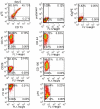Modeling initiation of Ewing sarcoma in human neural crest cells
- PMID: 21559395
- PMCID: PMC3084816
- DOI: 10.1371/journal.pone.0019305
Modeling initiation of Ewing sarcoma in human neural crest cells
Abstract
Ewing sarcoma family tumors (ESFT) are aggressive bone and soft tissue tumors that express EWS-ETS fusion genes as driver mutations. Although the histogenesis of ESFT is controversial, mesenchymal (MSC) and/or neural crest (NCSC) stem cells have been implicated as cells of origin. For the current study we evaluated the consequences of EWS-FLI1 expression in human embryonic stem cell-derived NCSC (hNCSC). Ectopic expression of EWS-FLI1 in undifferentiated hNCSC and their neuro-mesenchymal stem cell (hNC-MSC) progeny was readily tolerated and led to altered expression of both well established as well as novel EWS-FLI1 target genes. Importantly, whole genome expression profiling studies revealed that the molecular signature of established ESFT is more similar to hNCSC than any other normal tissue, including MSC, indicating that maintenance or reactivation of the NCSC program is a feature of ESFT pathogenesis. Consistent with this hypothesis, EWS-FLI1 induced hNCSC genes as well as the polycomb proteins BMI-1 and EZH2 in hNC-MSC. In addition, up-regulation of BMI-1 was associated with avoidance of cellular senescence and reversible silencing of p16. Together these studies confirm that, unlike terminally differentiated cells but consistent with bone marrow-derived MSC, NCSC tolerate expression of EWS-FLI1 and ectopic expression of the oncogene initiates transition to an ESFT-like state. In addition, to our knowledge this is the first demonstration that EWS-FLI1-mediated induction of BMI-1 and epigenetic silencing of p16 might be critical early initiating events in ESFT tumorigenesis.
Conflict of interest statement
Figures







References
-
- Riggi N, Stamenkovic I. The Biology of Ewing sarcoma. Cancer Lett. 2007;254:1–10. - PubMed
-
- Deneen B, Denny CT. Loss of p16 pathways stabilizes EWS/FLI1 expression and complements EWS/FLI1 mediated transformation. Oncogene. 2001;20:6731–6741. - PubMed
-
- Lessnick SL, Dacwag CS, Golub TR. The Ewing's sarcoma oncoprotein EWS/FLI induces a p53-dependent growth arrest in primary human fibroblasts. Cancer Cell. 2002;1:393–401. - PubMed
-
- Huang HY, Illei PB, Zhao Z, Mazumdar M, Huvos AG, et al. Ewing sarcomas with p53 mutation or p16/p14ARF homozygous deletion: a highly lethal subset associated with poor chemoresponse. J Clin Oncol. 2005;23:548–558. - PubMed
Publication types
MeSH terms
Grants and funding
LinkOut - more resources
Full Text Sources
Molecular Biology Databases
Research Materials

